The Effect of Retention Time and Seasonal Variation on the Characterization of Phyto-Remediated Aquaculture Wastewater in a Constructed Wetland
Abstract
Simple Summary
Abstract
1. Introduction
2. Methodology
2.1. The Study Location and the Description of the Experimental Setup
2.2. Operation of the Experiment
2.3. Statistics
3. Results and Discussion
3.1. Removal Efficiency of Parameters, Metals, and Heavy Metals
3.2. Main and Interactive Effect of Design and Operation Factors on the Wastewater’s Physical and Chemical Properties of the VSSF-CWs
4. Conclusions
Supplementary Materials
Author Contributions
Funding
Institutional Review Board Statement
Informed Consent Statement
Data Availability Statement
Conflicts of Interest
References
- Azabo, M.; Abdelhaleem, A.; Nasr, M. Feasibility of phytoremediation/pyrolysis/adsorption framework for valorization of water hyacinth: Life cycle assessment, techno-economics, and sustainability pillars. J. Water Process Eng. 2025, 71, 107146. [Google Scholar] [CrossRef]
- Azeez, O. Socioeconomic Predictors of Access to Improved Water Sources, Sanitation Facilities, and Household Water Treatment in Nigeria. Ph.D. Thesis, The University of Alabama, Tuscaloosa, AL, USA, 2023. [Google Scholar]
- Shivendra, B.T.; Ramaraju, H.K. Impact of onsite sanitation system on groundwater in different geological settings of peri urban areas. Aquat. Procedia 2015, 4, 1162–1172. [Google Scholar] [CrossRef]
- Weerakoon, W.M.G.S.K. Some Environmental Factors Influencing Diversity of Corticolous Lichens in Selected Disturbed and Undisturbed Vegetation Types in Knuckles Mountain Range in Sri Lanka. Ph.D. Thesis, University of Sri Jayewardenepura, Nugegoda, Sri Lanka, 2013. [Google Scholar]
- Nwankwo, N.; Olokpa, J.; Olaniyi, T. Synthesis of environmental sustainability framework for modular refinery in the Nigeria oil and gas sector. Int. J. Innov. Bus. Strateg. 2023, 9, 582–591. [Google Scholar] [CrossRef]
- Ghaly, A.E.; Abdelrahman, E.N.; Emam, R.H.; Mahmoud, N.S.; Ibrahim, M.M.; Mostafa, E.A.; Kassem, M.A.; Hatem, M.H. Overview of Biological Treatment Technologies for Greywater Reuse. Adn. Environ. Waste Manag. Recycl. 2021, 4, 165–191. [Google Scholar]
- Akinbile, C.O.; Akinlade, G.M.; Abolude, A.T. Trend analysis in climatic variables and impacts on rice yield in Nigeria. J. Water Clim. Change 2015, 6, 534–543. [Google Scholar] [CrossRef]
- Adabembe, B.A.; Fasinmirin, J.T.; Olanrewaju, O.O.; Dada, A.A.; Faloye, O.T. Phytoremediation of aquaculture wastewater using Azolla pinnata and evaluation of its suitability for irrigation purpose. Sustain. Water Resour. Manag. 2022, 8, 166. [Google Scholar] [CrossRef]
- Merino-Solís, M.L.; Villegas, E.; De Anda, J.; López-López, A. The effect of the hydraulic retention time on the performance of an ecological wastewater treatment system: An anaerobic filter with a constructed wetland. Water 2015, 7, 1149–1163. [Google Scholar] [CrossRef]
- Said, N.S.M.; Abdullah, S.R.S.; Ismail, N.I.; Hasan, H.A.; Othman, A.R. Phytoremediation of real coffee industry effluent through a continuous two-stage constructed wetland system. Environ. Technol. Innov. 2020, 17, 100502. [Google Scholar] [CrossRef]
- Sanou, L.; Zida, D.; Savadogo, P.; Thiombiano, A. Comparison of aboveground vegetation and soil seed bank composition at sites of different grazing intensity around a savanna-woodland watering point in West Africa. J. Plant Res. 2018, 131, 773–788. [Google Scholar] [CrossRef]
- Bonanno, G.; Giudice, R.L. Heavy metal bioaccumulation by the organs of Phragmites australis (common reed) and their potential use as contamination indicators. Ecol. Indic. 2010, 10, 639–645. [Google Scholar] [CrossRef]
- Kamchoom, V.; Chen, X.W.; Leung, A.K.; Sakolpanya, T.; Srinil, C. Dynamic changes in cellulose content and biomechanical properties of mycorrhizal roots during growth and decay. Plant Soil 2023, 490, 573–589. [Google Scholar] [CrossRef]
- Apriyono, A.; Yuliana, Y.; Chen, Z.; Keawsawasvong, S.; Kamchoom, V. The impact of biochar amendment on soil water infiltration and evaporation under climate change scenarios. Acta Geophys. 2024, 72, 3647–3660. [Google Scholar] [CrossRef]
- Chen, Z.; Kamchoom, V.; Leung, A.K.; Xue, J.; Chen, R. Influence of biochar on the water permeability of compacted clay subjected to freezing–thawing cycles. Acta Geophys. 2024, 72, 2071–2081. [Google Scholar] [CrossRef]
- Ewemoje, O.E.; Sangodoyin, A.Y.; Adegoke, A.T. On the effect of hydraulic retention time and loading rates on pollutant removal in a pilot scale wetland. J. Sustain. Dev. Stud. 2015, 8, 342–355. [Google Scholar]
- Gorgoglione, A.; Torretta, V. Sustainable management and successful application of constructed wetlands: A critical review. Sustainability 2018, 10, 3910. [Google Scholar] [CrossRef]
- Dotro, G.; Langergraber, G.; Molle, P.; Nivala, J.; Puigagut, J.; Stein, O.; Von Sperling, M. Treatment Wetlands; IWA Publishing: London, UK, 2017; p. 172. [Google Scholar]
- Patel, P.A.; Dharaiya, N.A. Manmade wetland for wastewater treatment with special emphasis on design criteria. Sci. Rev. Chem. 2013, 3, 150–160. [Google Scholar]
- Un-Habitat. State of the World’s Cities 2008/9: Harmonious Cities; Un-Habitat: Nairobi, Kenya, 2008; Earthscan. [Google Scholar]
- Chang, J.J.; Wu, S.Q.; Dai, Y.R.; Liang, W.; Wu, Z.B. Treatment performance of integrated vertical-flow constructed wetland plots for domestic wastewater. Ecol. Eng. 2012, 44, 152–159. [Google Scholar] [CrossRef]
- APHA (American Public Health Association). Standard Methods for the Examination of Water and Wastewater; APHA: Washington, DC, USA, 2012. [Google Scholar]
- Shruthi, R.; Shivashankara, G.P. Investigation on the performance evaluation of vertical subsurface flow constructed wetland for the treatment of rural wastewater. Water Sci. Technol. 2022, 85, 16–26. [Google Scholar] [CrossRef]
- Kadlec, R.H.; Reddy, K.R. Temperature effects in treatment wetlands. Water Environ. Res. 2001, 73, 543–557. [Google Scholar] [CrossRef]
- Zamora-Castro, S.A.; Marín-Muñiz, J.L.; Sandoval, L.; Vidal-Álvarez, M.; Carrión-Delgado, J.M. Effect of ornamental plants, seasonality, and filter media material in fill-and-drain constructed wetlands treating rural community wastewater. Sustainability 2019, 11, 2350. [Google Scholar] [CrossRef]
- Wiessner, A.; Rahman, K.Z.; Kuschk, P.; Kästner, M.; Jechorek, M. Dynamics of sulphur compounds in horizontal sub-surface flow laboratory-scale constructed wetlands treating artificial sewage. Water Res. 2010, 44, 6175–6185. [Google Scholar] [CrossRef] [PubMed]
- Baldwin, D.S.; Mitchell, A. Impact of sulfate pollution on anaerobic biogeochemical cycles in a wetland sediment. Water Res. 2012, 46, 965–974. [Google Scholar] [CrossRef]
- Hou, J.; Guo, W.; Wen, Y. Effect of Sulfate Load on Sulfur Removal in Model Constructed Wetlands. IOP Conf. Ser. Earth Environ. Sci. 2018, 186, 012078. [Google Scholar] [CrossRef]
- Ilyas, H.; van Hullebusch, E.D. Role of design and operational factors in the removal of pharmaceuticals by constructed wetlands. Water 2019, 11, 2356. [Google Scholar] [CrossRef]
- Schück, M.; Greger, M. Chloride removal capacity and salinity tolerance in wetland plants. J. Environ. Manag. 2022, 308, 114553. [Google Scholar] [CrossRef] [PubMed]
- Zeng, Y.; Xu, W.; Wang, H.; Zhao, D.; Ding, H. Nitrogen and Phosphorus Removal Efficiency and Denitrification Kinetics of Different Substrates in Constructed Wetland. Water 2022, 14, 1757. [Google Scholar] [CrossRef]
- Polińska, W.; Piotrowska-Niczyporuk, A.; Karpińska, J.; Struk-Sokołowska, J.; Kotowska, U. Mechanisms, toxicity and optimal conditions-research on the removal of benzotriazoles from water using Wolffia arrhiza. Sci. Total Environ. 2022, 847, 157571. [Google Scholar] [CrossRef]
- Ansari, A.A.; Naeem, M.; Gill, S.S.; AlZuaibr, F.M. Phytoremediation of contaminated waters: An eco-friendly technology based on aquatic macrophytes application. Egypt. J. Aquat. Res. 2020, 46, 371–376. [Google Scholar] [CrossRef]
- Kadlec, R.H.; Wallace, S.D. Treatment Wetlands, 2nd ed.; CRC Press: Boca Raton, FL, USA, 2009. [Google Scholar]
- Akinbile, C.O.; Ogunrinde, T.A.; Che bt Man, H.; Aziz, H.A. Phytoremediation of domestic wastewaters in free water surface constructed wetlands using Azolla pinnata. Int. J. Phytorem. 2022, 18, 54–61. [Google Scholar] [CrossRef]
- Rahman, M.E.; Bin Halmi, M.I.E.; Bin Abd Samad, M.Y.; Uddin, M.K.; Mahmud, K.; Abd Shukor, M.Y.; Shamsuzzaman, S.M. Design, operation and optimization of constructed wetland for removal of pollutant. Int. J. Environ. Res. Public Health 2020, 17, 8339. [Google Scholar] [CrossRef]
- Angassa, K.; Leta, S.; Mulat, W.; Kloos, H. Seasonal characterization of municipal wastewater and performance evaluation of a constructed wetland system in Addis Ababa, Ethiopia. Int. J. Energy Water Resour. 2020, 4, 127–138. [Google Scholar] [CrossRef]
- Akadiri, S.A.; Dada, P.O.; Badejo, A.A.; Adeosun, O.J.; Ogunrinde, A.T.; Faloye, O.T. Phytoremediation of an integrated poultry and aquaculture wastewater using sub-surface constructed wetland planted with Phragmites karka and Typha latifolia. Int. J. Phytorem. 2023, 26, 1133–1143. [Google Scholar] [CrossRef]
- Kumar, R.; Singh, B. Grid interactive solar PV-based water pumping using BLDC motor drive. IEEE Trans. Ind. Appl. 2019, 55, 5153–5165. [Google Scholar] [CrossRef]
- Calheiros, C.S.; Bessa, V.S.; Mesquita, R.B.; Brix, H.; Rangel, A.O.; Castro, P.M. Constructed wetland with a polyculture of ornamental plants for wastewater treatment at a rural tourism facility. Ecol. Eng. 2015, 79, 1–7. [Google Scholar] [CrossRef]
- Kaseva, M.E.; Mbuligwe, S.E. Potential of constructed wetland systems for treating tannery industrial wastewater. Water Sci. Technol. 2010, 61, 1043–1052. [Google Scholar] [CrossRef]
- Saeed, T.; Afrin, R.; Al Muyeed, A.; Sun, G. Treatment of tannery wastewater in a pilot-scale hybrid constructed wetland system in Bangladesh. Chemosphere 2012, 88, 1065–1073. [Google Scholar] [CrossRef] [PubMed]
- Sinton, L.W.; Hall, C.H.; Lynch, P.A.; Davies-Colley, R.J. Sunlight inactivation of fecal indicator bacteria and bacteriophages from waste stabilization pond effluent in fresh and saline waters. Appl. Environ. Microbiol. 2002, 68, 1122–1131. [Google Scholar] [CrossRef]
- Dahl, N.W.; Woodfield, P.L.; Lemckert, C.J.; Stratton, H.; Roiko, A. A practical model for sunlight disinfection of a subtropical maturation pond. Water Res. 2017, 108, 151–159. [Google Scholar] [CrossRef] [PubMed]
- Wang, N.; Luo, C.; Wu, X.; Chen, L.; Ge, X.; Huang, C.; Lin, X.; Zhu, S. Effects of water temperature on growth of invasive Myriophyllum aquaticum species. Aquat. Invasions 2024, 19, 153–167. [Google Scholar] [CrossRef]
- Haris, H.; Fai, C.M.; Bahruddin, A.S.B.; Dinesh, A.A. Effect of Temperature on Nutrient Removal Efficiency of Water Hyacinth for Phytoremediation Treatment. Int. J. Eng. Technol. 2018, 7, 81–84. [Google Scholar] [CrossRef]
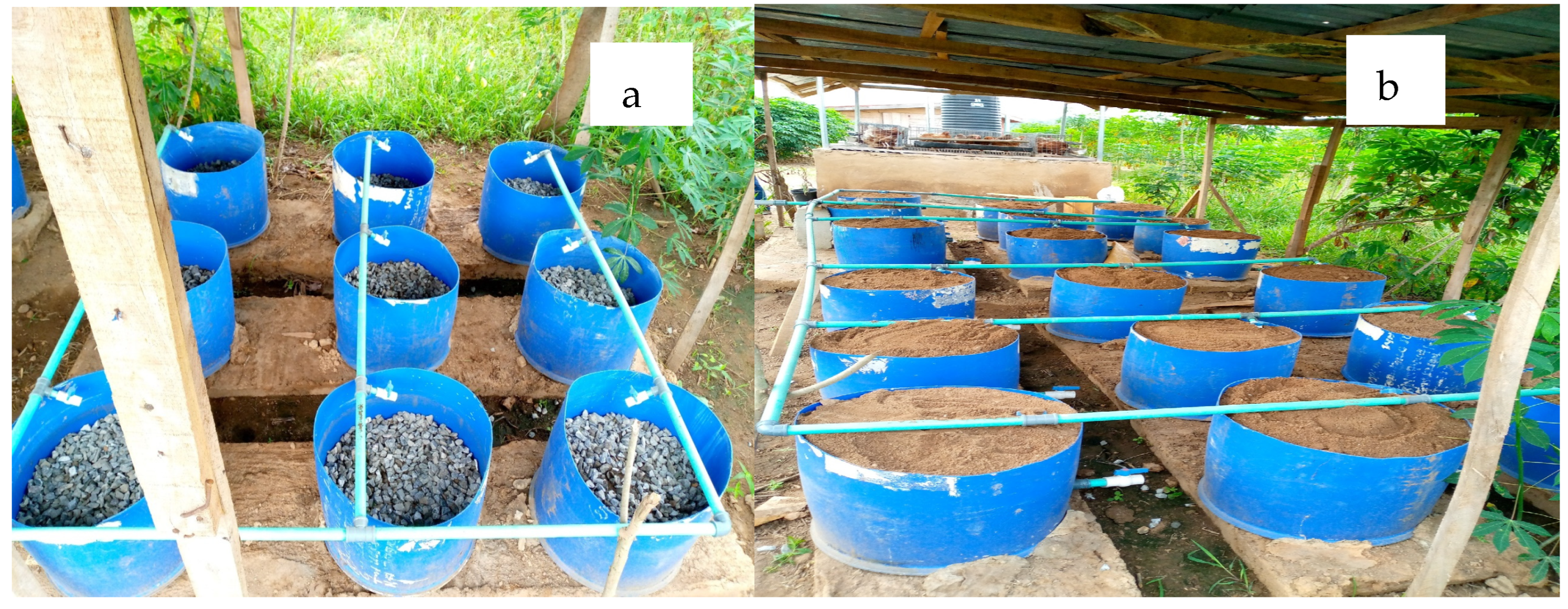
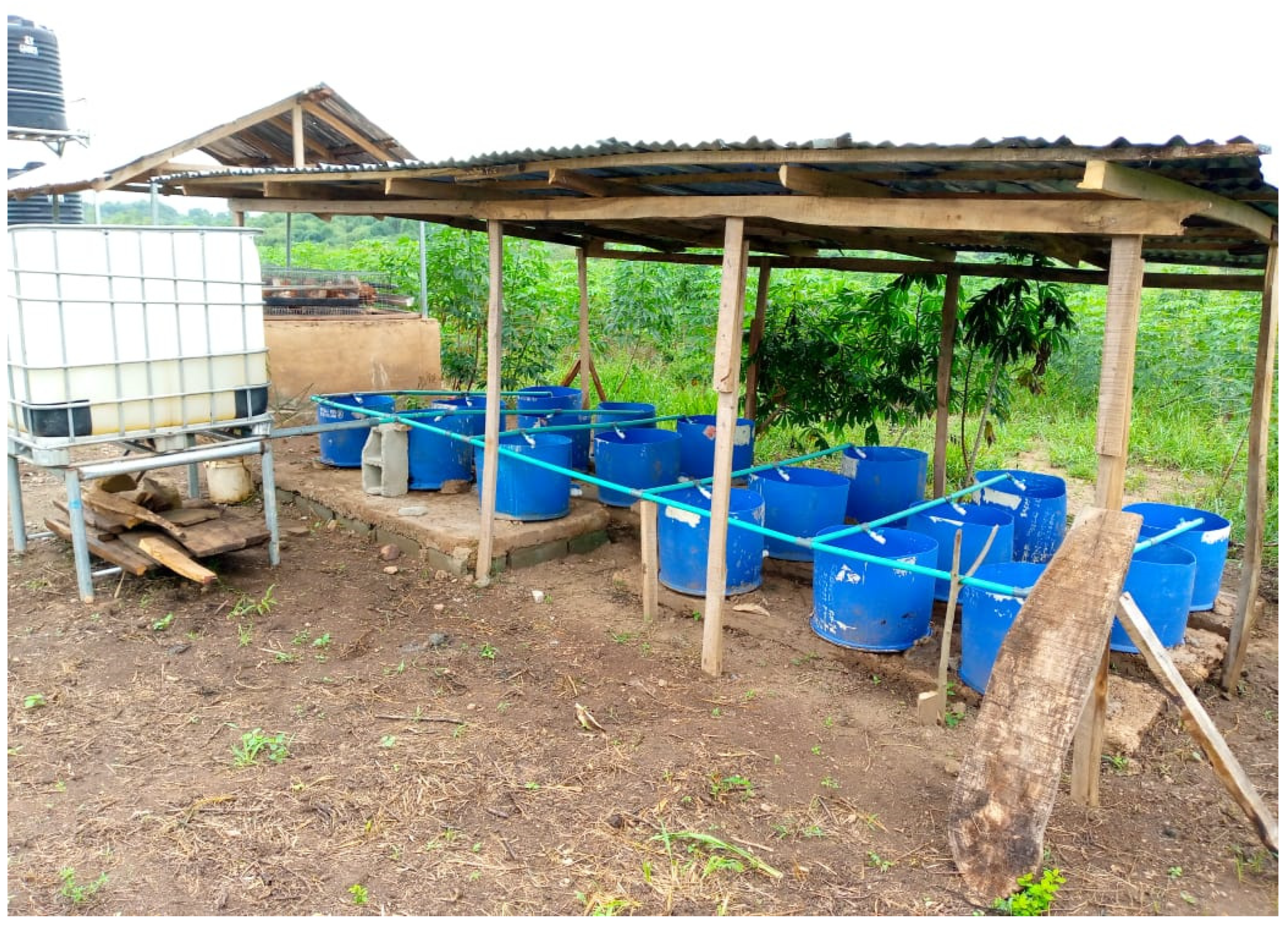
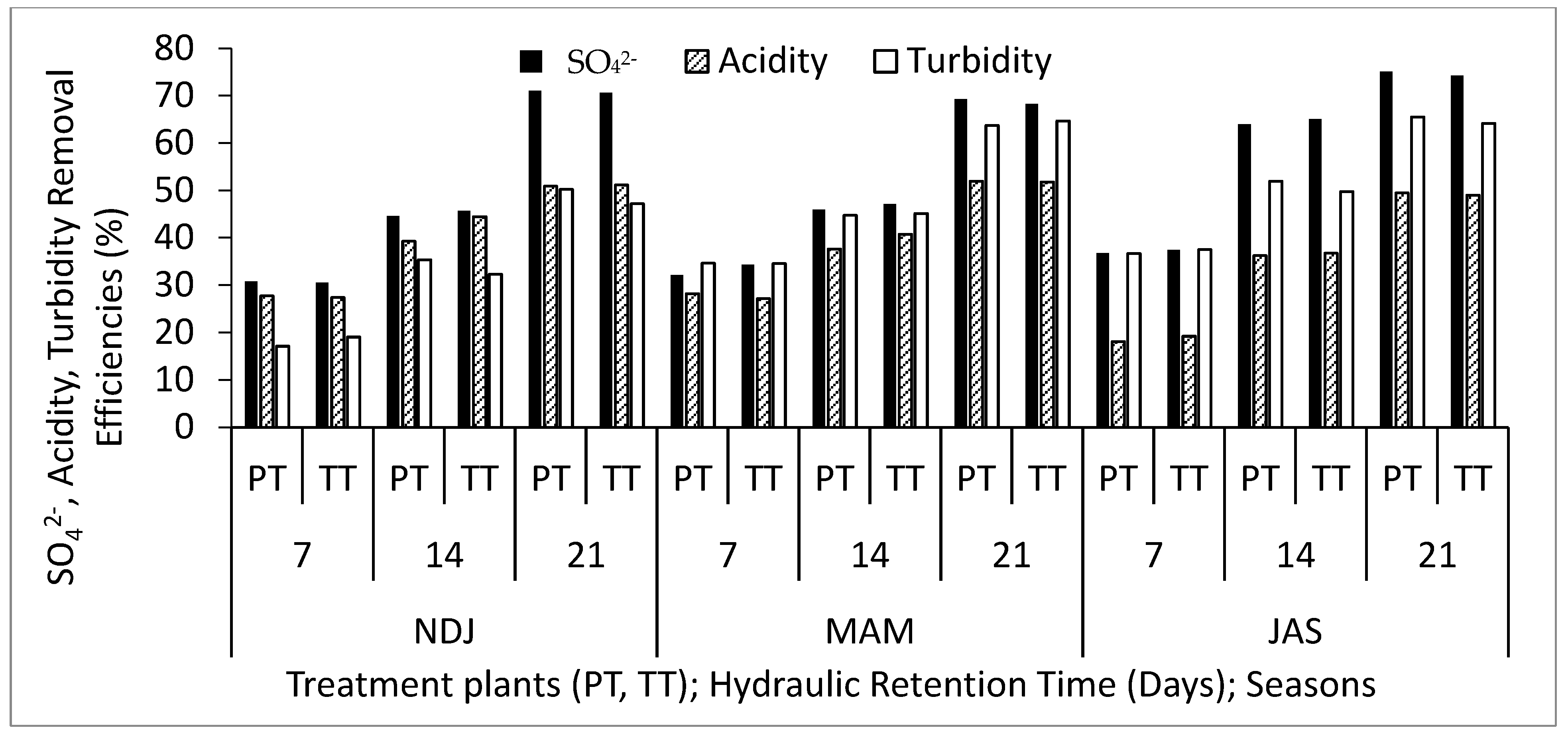
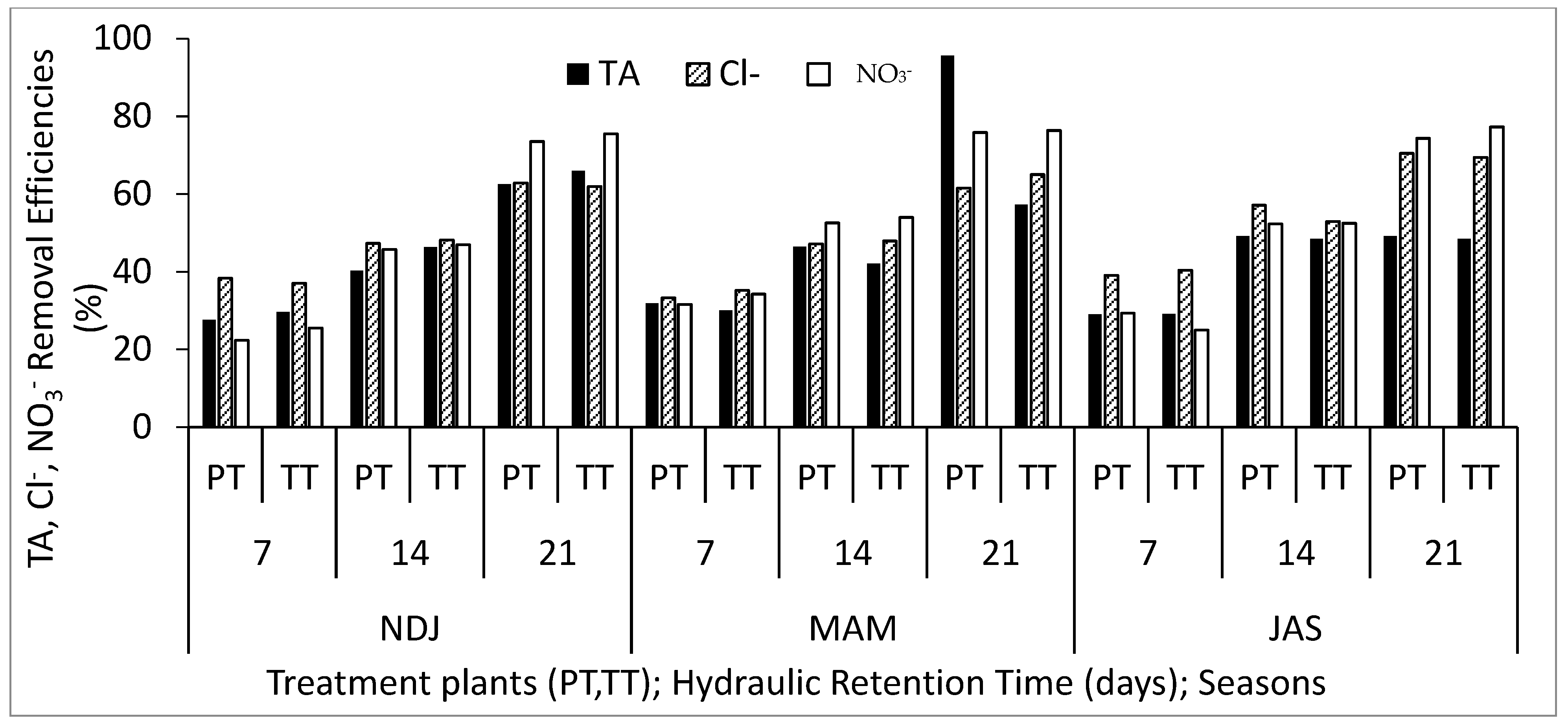
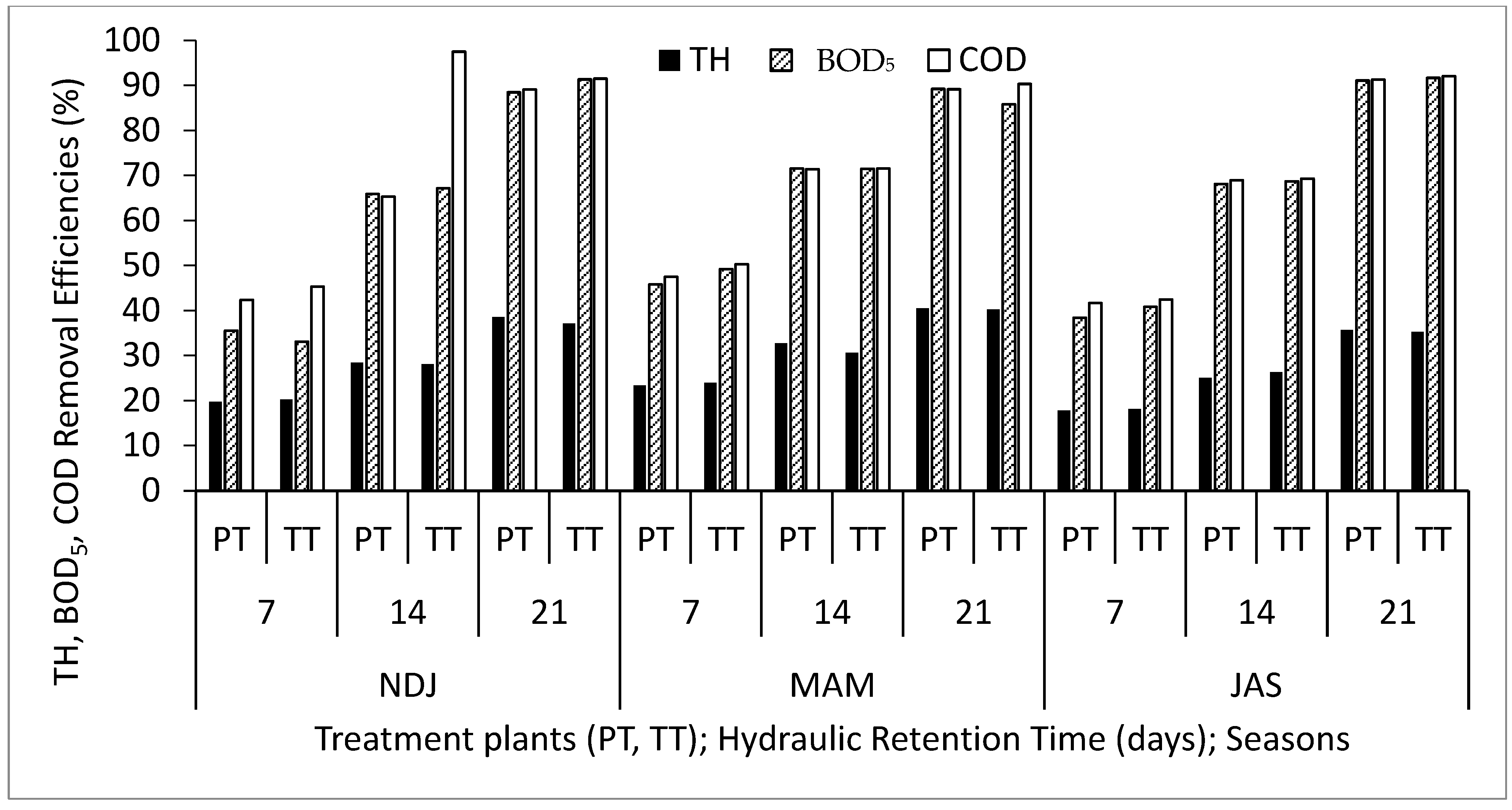
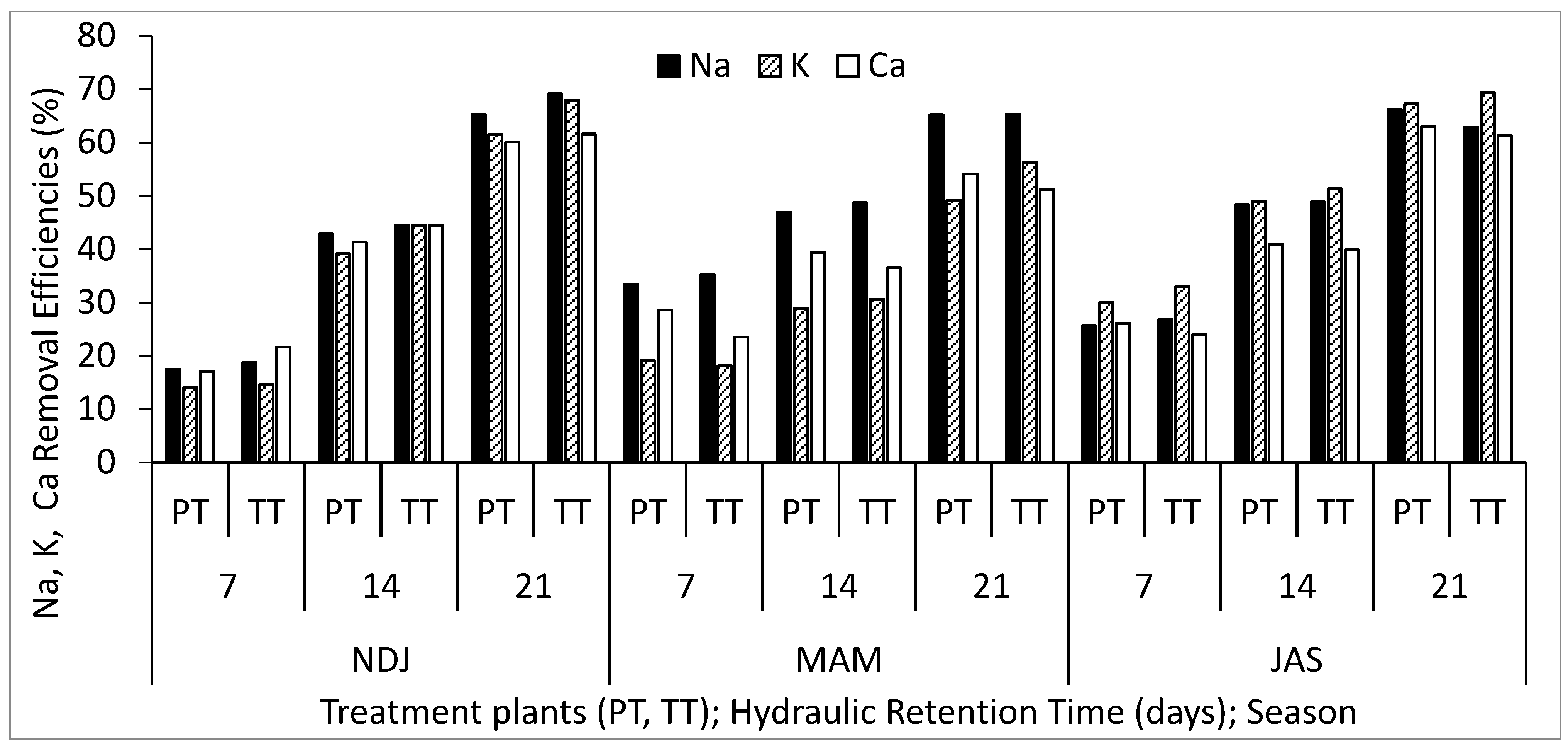
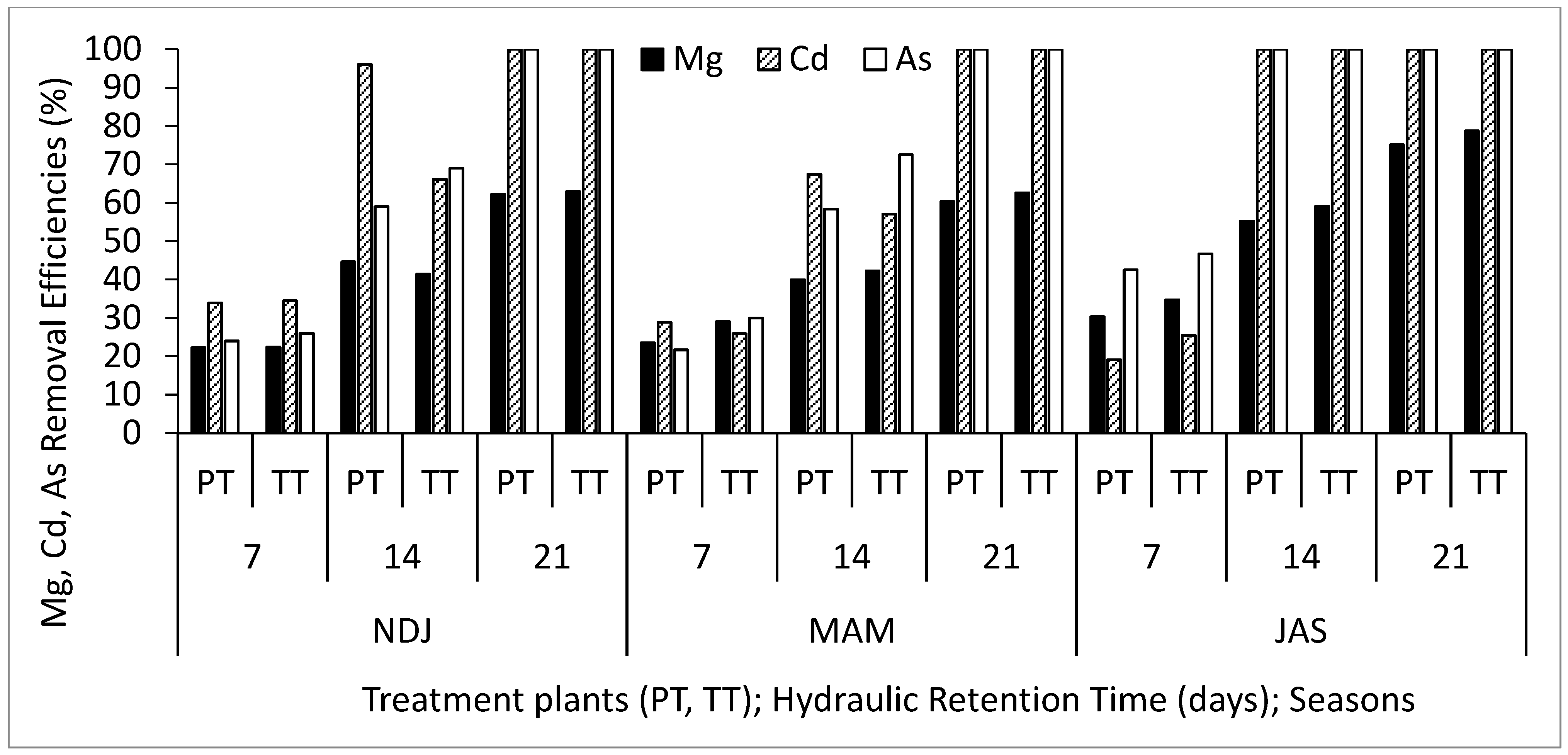
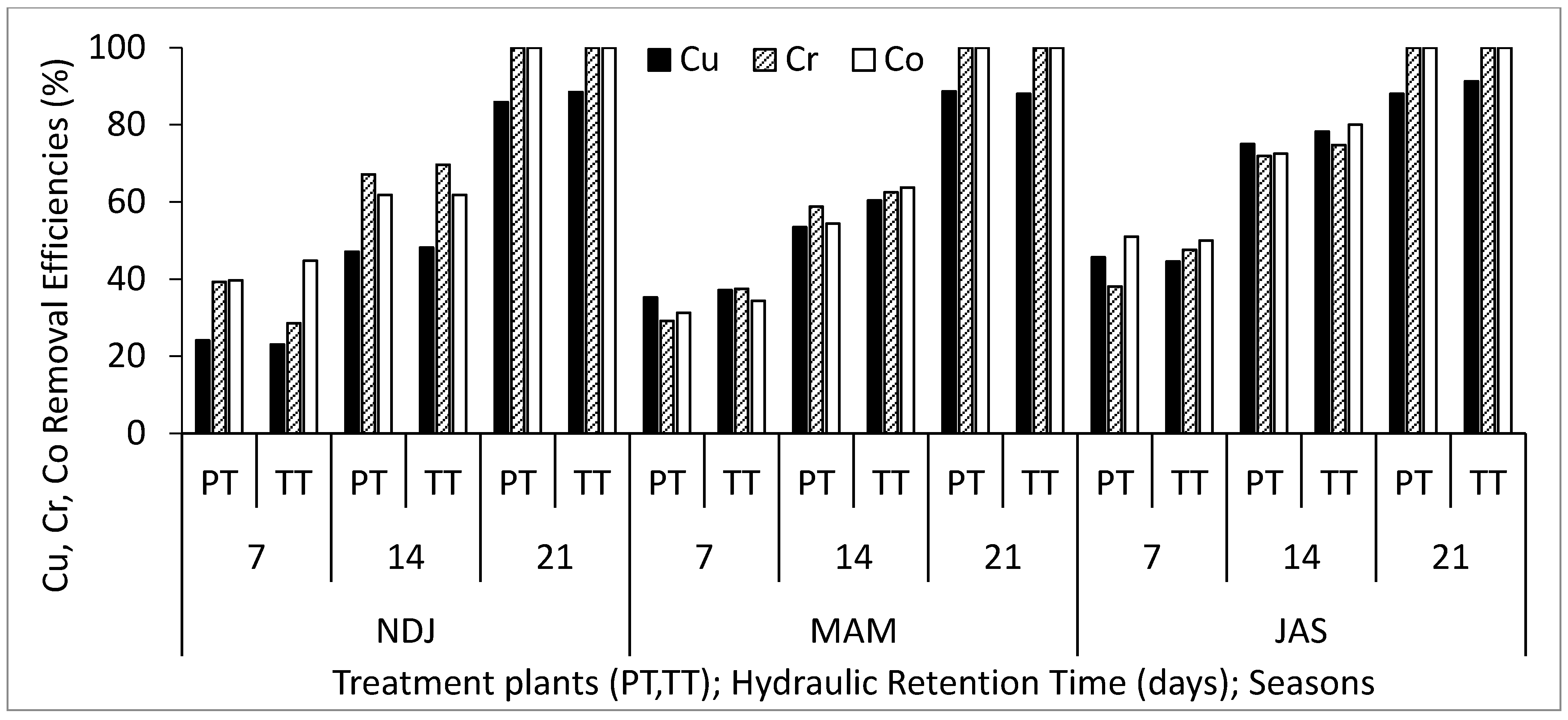
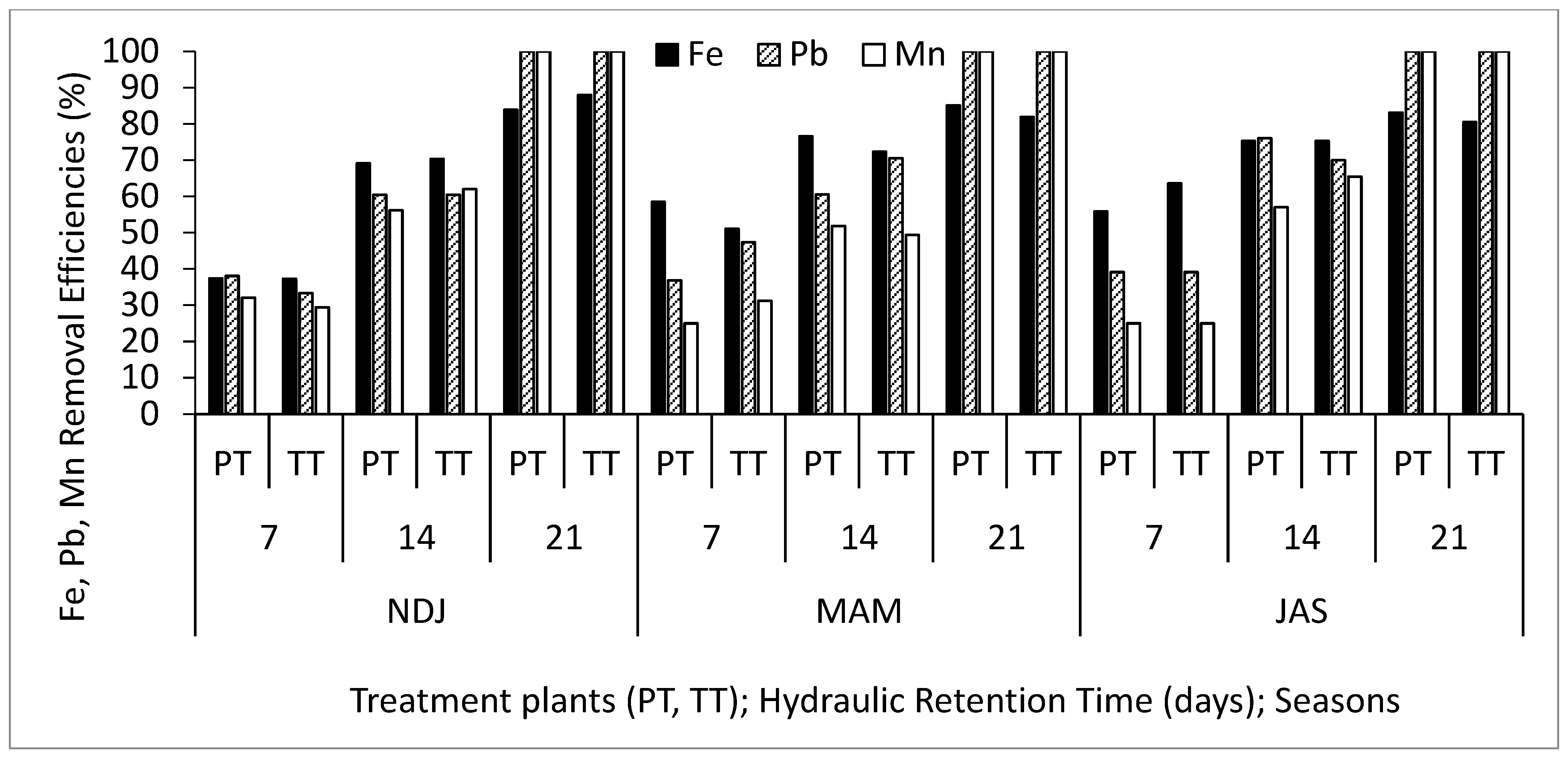
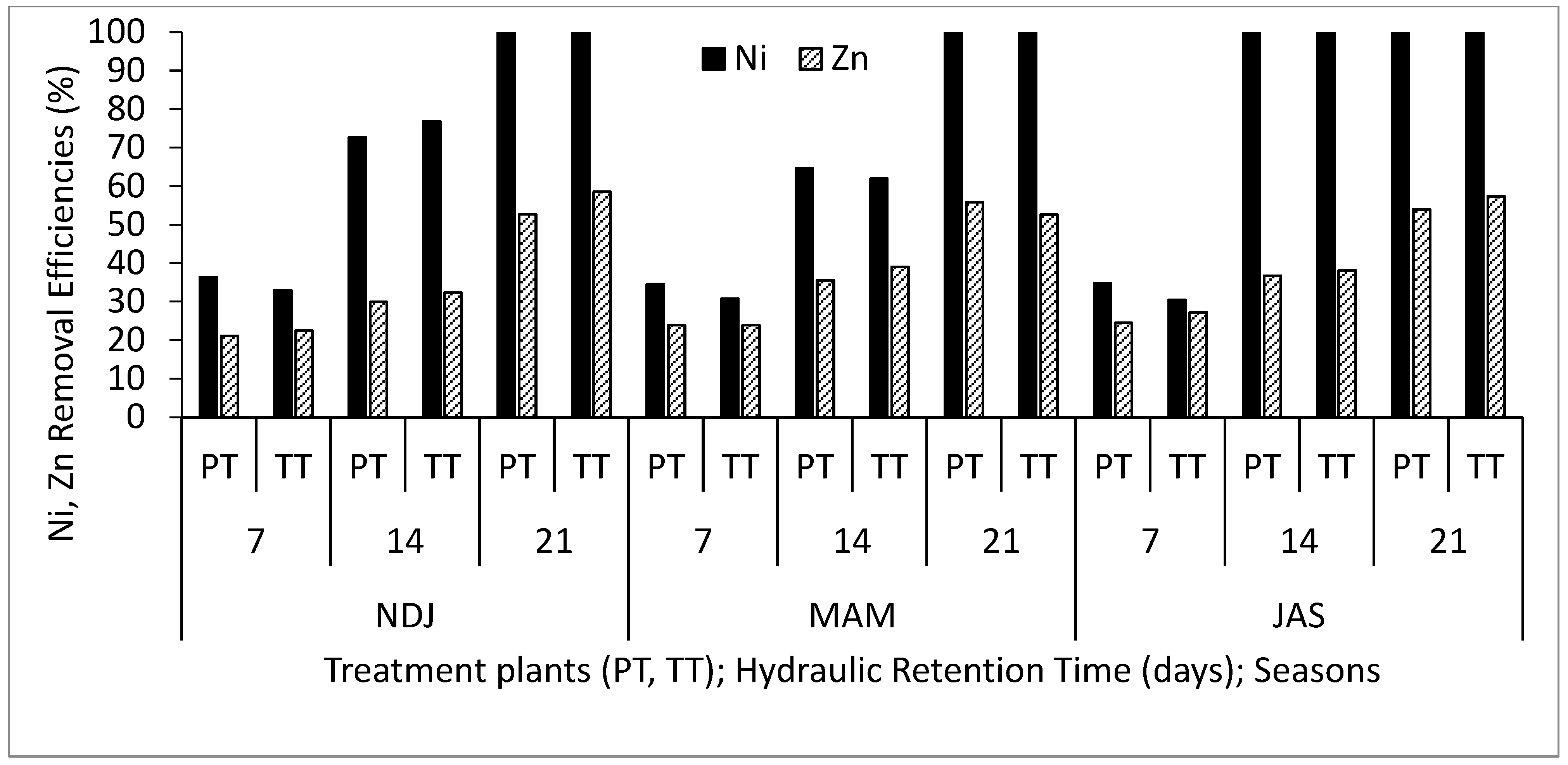
| Parameter | Instruments or Test Method Used |
|---|---|
| Temperature | Thermometer (model, HI 9024 HANNA, Padova, Italy) |
| Turbidity | Nephelometer or turbidimeter |
| Total hardness (TH) | Titration using ethylenediaminetetraacetic acid (EDTA) |
| BOD5 | BOD self-check measurement (208215 OxiTop® IS 12, Global water a Xylem brand, Milford, OH, USA) |
| COD | Method 8000—reactor digestion method by a spectrophotometer |
| Cl− | Silver nitrate titration method (APHA, 2012) [22] |
| NO3− | Spectrophotometry (colorimetric method) |
| SO42− | Gravimetric sulphate determination method (APHA, 2012) [22] |
| Na, K, Ca, Mg | Atomic Adsorption Spectrophotometry (AAS) |
| As, Cd, Cu, Cr, Co, Fe, Pb, Mn, Zn, Ni | Atomic Adsorption Spectrophotometry (AAS) |
| 7 | 14 | 21 | |||||
|---|---|---|---|---|---|---|---|
| Parameters | RWW | PT | TT | PT | TT | PT | TT |
| Temperature (°C) | 26.37 ± 0.50a | 26.43 ± 0.53a | 26.38 ± 0.47a | 26.76 ± 0.21a | 26.52 ± 0.42a | 26.16 ± 0.19a | 26.06 ± 0.04a |
| Colour (HU) | 11.77 ± 0.93a | 8.49 ± 0.61b | 8.46 ± 0.63b | 7.21 ± 0.74b | 7.28 ± 0.74b | 6.17 ± 0.64b | 6.29 ± 0.71b |
| pH | 8.22 ± 0.11a | 7.70 ± 0.18b | 7.80 ± 0.13b | 7.45 ± 0.15b | 7.45 ± 0.24b | 7.24 ± 0.07b | 7.23 ± 0.13b |
| DO (mg/L) | 0.17 ± 0.07a | 2.18 ± 0.06b | 2.21 ± 0.07b | 3.44 ± 0.26b | 3.45 ± 0.26b | 4.75 ± 0.23b | 4.80 ± 0.12b |
| Turbidity | 11.5 ± 81.19a | 8.09 ± 0.45b | 7.99 ± 0.43b | 6.43 ± 0.59b | 6.61 ± 0.50b | 4.59 ± 0.48b | 4.71 ± 0.61b |
| Acidity | 123.67 ± 8.08a | 92.89 ± 2.70b | 93.04 ± 2.00b | 76.96 ± 3.24b | 73.22 ± 0.76b | 60.85 ± 3.18b | 60.99 ± 2.73b |
| Total acidity (TA) | 184.33 ± 14.19a | 130.00 ± 11.57b | 129.58 ± 9.49b | 95.770 ± 8.57b | 100.36 ± 11.55b | 80.04 ± 6.01b | 78.04 ± 10.23b |
| Total hardness (TH) | 74.83 ± 4.25a | 59.59 ± 1.94a | 59.22.77 ± 1.85b | 53.23 ± 1.31b | 53.55 ± 1.78b | 46.15 ± 1.04b | 46.68 ± 1.39b |
| Cl− | 53.67 ± 6.17a | 33.84 ± 3.57b | 33.45 ± 2.78b | 26.35 ± 1.01b | 26.92 ± 1.67b | 18.64 ± 1.19b | 18.39 ± 0.17b |
| NO3− | 40.17 ± 1.75a | 29.00 ± 1.74b | 28.77 ± 0.96b | 20.00 ± 1.55b | 19.62 ± 1.35b | 10.21 ± 0.30b | 9.50 ± 0.61b |
| SO42− | 117.80 ± 2.41a | 78.67 ± 3.57b | 77.62 ± 3.32b | 57.13 ± 12.66b | 55.79 ± 12.60b | 33.24 ± 3.80b | 34.13 ± 3.86b |
| BOD5 | 29.50 ± 2.27a | 17.65 ± 0.63b | 17.29 ± 1.54b | 9.26 ± 0.43b | 9.08 ± 0.32b | 3.09 ± 0.52b | 3.12 ± 1.25b |
| COD | 56.67 ± 4.22a | 31.73 ± 0.51b | 30.49 ± 0.48b | 17.77 ± 1.17b | 11.79 ± 9.02b | 5.79 ± 1.01b | 4.97 ± 0.88b |
| Na | 70.65 ± 6.12a | 52.71 ± 9.99b | 51.71 ± 10.01b | 38.11 ± 5.47b | 37.17 ± 5.10b | 24.22 ± 2.39b | 23.95 ± 0.45b |
| K | 73.19 ± 14.71a | 57.75 ± 12.26b | 56.98 ± 11.91b | 43.90 ± 5.16b | 41.49 ± 3.41b | 28.96 ± 2.40b | 25.32 ± 0.79b |
| Ca | 35.41 ± 6.73a | 27.18 ± 7.27b | 27.30 ± 5.64b | 21.03 ± 3.83b | 21.02 ± 3.05b | 14.52 ± 3.20b | 14.81 ± 2.94b |
| Mg | 42.80 ± 3.57a | 32.04 ± 4.43b | 30.65 ± 5.11b | 23.01 ± 4.86b | 22.67 ± 5.91b | 14.77 ± 4.41b | 13.86 ± 4.86b |
| As | 0.11 ± 0.01a | 0.08 ± 0.01b | 0.07 ± 0.01b | 0.05 ± 0.01b | 0.03b | ND | ND |
| Cd | 0.14 ± 0.04a | 0.10 ± 0.02b | 0.10 ± 0.02b | 0.03 ± 0.03b | 0.06b | ND | ND |
| Cu | 1.78 ± 0.17a | 1.16 ± 0.25b | 1.16 ± 0.27b | 0.74 ± 0.28b | 0.67 ± 0.30b | 0.22 ± 0.05b | 0.19 ± 0.03b |
| Cr | 0.24 ± 0.04a | 0.16 ± 0.02b | 0.15 ± 0.05b | 0.08 ± 0.02b | 0.08 ± 0.02b | ND | ND |
| Co | 0.19 ± 0.02a | 0.11 ± 0.01b | 0.14 ± 0.05b | 0.07 ± 0.01b | 0.06 ± 0.02b | ND | ND |
| Fe | 0.84 ± 0.09a | 0.41 ± 0.09b | 0.42 ± 0.12b | 0.22 ± 0.03b | 0.23 ± 0.04b | 0.13 ± 0.01b | 0.14 ± 0.04b |
| Pb | 0.21 ± 0.02a | 0.13 ± 0.01b | 0.13 ± 0.01b | 0.07 ± 0.01b | 0.07 ± 0.01b | ND | ND |
| Mn | 0.18 ± 0.02a | 0.13 ± 0.02b | 0.13 ± 0.02b | 0.08b | 0.07 ± 0.01b | ND | ND |
| Zn | 2.97 ± 0.12a | 2.28 ± 0.11b | 2.24 ± 0.14b | 1.96 ± 0.13b | 1.88 ± 0.11b | 1.36 ± 0.04b | 1.30 ± 0.14b |
| Ni | 0.29 ± 0.08a | 0.19 ± 0.05b | 0.20 ± 0.05b | 0.10 ± 0.01b | 0.09 ± 0.01b | ND | ND |
| Year 2021–2022 | Nov | Dec | Jan | Feb | Mar | Apr | May | Jun | Jul | Aug | Sep | Oct |
|---|---|---|---|---|---|---|---|---|---|---|---|---|
| T max °C | 29.36 | 30.22 | 29.76 | 31.13 | 30.54 | 29.13 | 29.44 | 28.18 | 27.81 | 27.67 | 27.91 | 29.07 |
| T min °C | 23.70 | 21.66 | 19.54 | 21.59 | 24.38 | 23.80 | 23.79 | 23.02 | 22.42 | 21.67 | 22.54 | 23.11 |
| T avg °C | 26.53 | 25.94 | 24.65 | 26.36 | 27.46 | 26.46 | 26.62 | 25.60 | 25.12 | 24.67 | 25.23 | 26.09 |
| Parameters | HRT | Seasons | TPs | HRT*Seasons | HRT*TPs | HRT*Season*TPs |
|---|---|---|---|---|---|---|
| Main effect | Interactive effect | |||||
| Temperature | ns | ** | ns | ns | ns | ns |
| Turbidity (NTU) | **** | ns | **** | ns | *** | ns |
| pH | **** | **** | **** | ns | **** | ns |
| DO (mg/L) | **** | *** | **** | ns | **** | ns |
| Acidity | **** | *** | **** | ns | **** | ns |
| TH | **** | **** | **** | ns | **** | ns |
| Cl− (mg/L) | **** | **** | **** | ns | **** | ns |
| NO3− (mg/L) | **** | ** | **** | ns | **** | ns |
| SO42− (mg/L) | **** | ** | **** | ns | **** | ns |
| BOD (mg/L) | **** | * | **** | ns | **** | ns |
| COD (mg/L) | **** | ns | **** | ns | **** | ns |
| Na (mg/L) | **** | **** | **** | *** | **** | ns |
| K (mg/L) | **** | *** | **** | ns | *** | ns |
| Ca (mg/L) | **** | **** | **** | * | **** | ns |
| Mg (mg/L) | *** | *** | **** | ns | ** | ns |
| Parameters | HRT | Seasons | TPs | HRT*Seasons | HRT*TPs | HRT*Season*TPs |
|---|---|---|---|---|---|---|
| Main effect | Interactive effect | |||||
| Cu (mg/L) | **** | *** | **** | ns | **** | ns |
| Fe (mg/L) | **** | ** | **** | ns | *** | ns |
| Zn (mg/L) | * | ns | ** | ns | ns | ns |
Disclaimer/Publisher’s Note: The statements, opinions and data contained in all publications are solely those of the individual author(s) and contributor(s) and not of MDPI and/or the editor(s). MDPI and/or the editor(s) disclaim responsibility for any injury to people or property resulting from any ideas, methods, instructions or products referred to in the content. |
© 2025 by the authors. Licensee MDPI, Basel, Switzerland. This article is an open access article distributed under the terms and conditions of the Creative Commons Attribution (CC BY) license (https://creativecommons.org/licenses/by/4.0/).
Share and Cite
Akadiri, S.A.; Dada, P.O.O.; Badejo, A.A.; Adeosun, O.J.; Ogunrinde, A.T.; Faloye, O.T.; Kamchoom, V.; Adeyeri, O.E. The Effect of Retention Time and Seasonal Variation on the Characterization of Phyto-Remediated Aquaculture Wastewater in a Constructed Wetland. Biology 2025, 14, 1390. https://doi.org/10.3390/biology14101390
Akadiri SA, Dada POO, Badejo AA, Adeosun OJ, Ogunrinde AT, Faloye OT, Kamchoom V, Adeyeri OE. The Effect of Retention Time and Seasonal Variation on the Characterization of Phyto-Remediated Aquaculture Wastewater in a Constructed Wetland. Biology. 2025; 14(10):1390. https://doi.org/10.3390/biology14101390
Chicago/Turabian StyleAkadiri, Shadrach A., Pius O. O. Dada, Adekunle A. Badejo, Olayemi J. Adeosun, Akinwale T. Ogunrinde, Oluwaseun T. Faloye, Viroon Kamchoom, and Oluwafemi E. Adeyeri. 2025. "The Effect of Retention Time and Seasonal Variation on the Characterization of Phyto-Remediated Aquaculture Wastewater in a Constructed Wetland" Biology 14, no. 10: 1390. https://doi.org/10.3390/biology14101390
APA StyleAkadiri, S. A., Dada, P. O. O., Badejo, A. A., Adeosun, O. J., Ogunrinde, A. T., Faloye, O. T., Kamchoom, V., & Adeyeri, O. E. (2025). The Effect of Retention Time and Seasonal Variation on the Characterization of Phyto-Remediated Aquaculture Wastewater in a Constructed Wetland. Biology, 14(10), 1390. https://doi.org/10.3390/biology14101390







